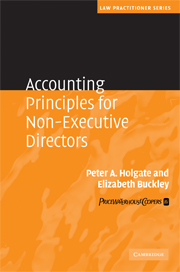Book contents
- Frontmatter
- Contents
- Acknowledgements
- Which standards and legislation has this book been based on?
- Glossary of terms
- Part I The accounting environment
- Part II Some specifics
- 8 Individual entity and consolidated financial statements
- 9 Presentation of financial statements
- 10 Earnings per share
- 11 Mergers and acquisitions
- 12 Interaction of accounting with tax
- 13 Assets
- 14 Liabilities
- 15 Leases
- 16 Pensions
- 17 Financial instruments
- 18 Share-based payment
- 19 Realised and distributable profits
- 20 Disclosures in published annual reports
- Appendices
- Index
16 - Pensions
from Part II - Some specifics
Published online by Cambridge University Press: 02 November 2009
- Frontmatter
- Contents
- Acknowledgements
- Which standards and legislation has this book been based on?
- Glossary of terms
- Part I The accounting environment
- Part II Some specifics
- 8 Individual entity and consolidated financial statements
- 9 Presentation of financial statements
- 10 Earnings per share
- 11 Mergers and acquisitions
- 12 Interaction of accounting with tax
- 13 Assets
- 14 Liabilities
- 15 Leases
- 16 Pensions
- 17 Financial instruments
- 18 Share-based payment
- 19 Realised and distributable profits
- 20 Disclosures in published annual reports
- Appendices
- Index
Summary
Introduction
Pensions have become a considerable economic and political problem. Deficits have risen due to increased longevity, lower interest rates and poor investment performance, relative to a decade ago. Pensions accounting questions arise in two contexts: in relation to the financial statements of pension schemes themselves and in relation to the treatment of the cost of pensions in the financial statements of the sponsoring companies. It is with the latter question that this chapter is concerned. The current accounting rules are set out in IAS 19 ‘Employee benefits’ and FRS 17 ‘Retirement benefits’.
In addition, various disclosures have to be made about the pension accruing to the individual directors of quoted companies; these are dealt with in chapter 20 under ‘Directors’ Remuneration Reports'.
Defined contribution and defined benefit schemes
Fundamentally, pension schemes take one of two forms.
Defined contribution schemes
A defined contribution (DC) scheme, or plan, is defined as one ‘under which an entity pays fixed contributions into a separate entity (a fund) and will have no legal or constructive obligation to pay further contributions if the fund does not hold sufficient assets to pay all employee benefits relating to employee service in the current and prior periods’. So, for example, the employee might pay 5 per cent of pensionable pay into the fund each year and the employer might pay 8 per cent of pensionable pay. A fund is a separate legal entity that looks after the money on behalf of the employees. The money in the fund is invested by the fund's managers.
- Type
- Chapter
- Information
- Accounting Principles for Non-Executive Directors , pp. 148 - 155Publisher: Cambridge University PressPrint publication year: 2009

